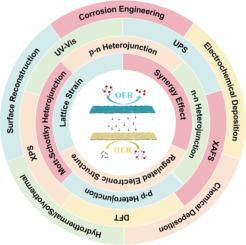Transition metal-based heterojunctions for alkaline electrocatalytic water splitting
IF 20.3
1区 化学
Q1 CHEMISTRY, INORGANIC & NUCLEAR
引用次数: 0
Abstract
Electrocatalytic water splitting is an attractive strategy for generating hydrogen energy, involving the hydrogen evolution reaction (HER) at cathode and the oxygen evolution reaction (OER) at anode. Given the sluggish reaction kinetics often observed in alkaline electrolytes, there is a critical need for catalysts that can lower the energy barrier and accelerate the reaction rates. Transition metal-based catalysts hold significant potential to replace conventional noble metal catalysts due to their earth abundance, cost-effectiveness, and adjustable activity. To achieve electrocatalytic activity similar to, or even surpassing, that of precious metals, constructing heterogeneous structures proves to be an effective strategy. Within a heterojunction, the two components work synergistically to promote the electrocatalytic process. The lattice strain and electron transfer in a heterojunction can modulate the electronic structure of active sites, optimizing the adsorption of reaction intermediates and accelerating reaction kinetics. In this review, we offer an overview of the characteristics, types, characterization and synthesis methods of heterojunctions. Additionally, we delve into the application of heterojunctions in HER, OER, and overall water splitting. Finally, we present an overview of the existing challenges in developing heterojunctions and offer a perspective on the prospective utilization of heterojunctions for hydrogen generation.

用于碱性电催化水分离的过渡金属基异质结
电催化水分裂是一种极具吸引力的氢能生成策略,它涉及阴极的氢进化反应(HER)和阳极的氧进化反应(OER)。鉴于在碱性电解质中经常观察到反应动力学迟缓,因此亟需能够降低能量障碍并加快反应速率的催化剂。基于过渡金属的催化剂具有丰富的地球资源、成本效益和可调节的活性,因此具有取代传统贵金属催化剂的巨大潜力。为了实现与贵金属相近甚至超越贵金属的电催化活性,构建异质结构被证明是一种有效的策略。在异质结中,两种成分协同作用,促进电催化过程。异质结中的晶格应变和电子转移可以调节活性位点的电子结构,优化反应中间产物的吸附并加速反应动力学。在本综述中,我们将概述异质结的特点、类型、表征和合成方法。此外,我们还深入探讨了异质结在 HER、OER 和整体水分离中的应用。最后,我们概述了开发异质结所面临的挑战,并展望了利用异质结制氢的前景。
本文章由计算机程序翻译,如有差异,请以英文原文为准。
求助全文
约1分钟内获得全文
求助全文
来源期刊

Coordination Chemistry Reviews
化学-无机化学与核化学
CiteScore
34.30
自引率
5.30%
发文量
457
审稿时长
54 days
期刊介绍:
Coordination Chemistry Reviews offers rapid publication of review articles on current and significant topics in coordination chemistry, encompassing organometallic, supramolecular, theoretical, and bioinorganic chemistry. It also covers catalysis, materials chemistry, and metal-organic frameworks from a coordination chemistry perspective. Reviews summarize recent developments or discuss specific techniques, welcoming contributions from both established and emerging researchers.
The journal releases special issues on timely subjects, including those featuring contributions from specific regions or conferences. Occasional full-length book articles are also featured. Additionally, special volumes cover annual reviews of main group chemistry, transition metal group chemistry, and organometallic chemistry. These comprehensive reviews are vital resources for those engaged in coordination chemistry, further establishing Coordination Chemistry Reviews as a hub for insightful surveys in inorganic and physical inorganic chemistry.
 求助内容:
求助内容: 应助结果提醒方式:
应助结果提醒方式:


